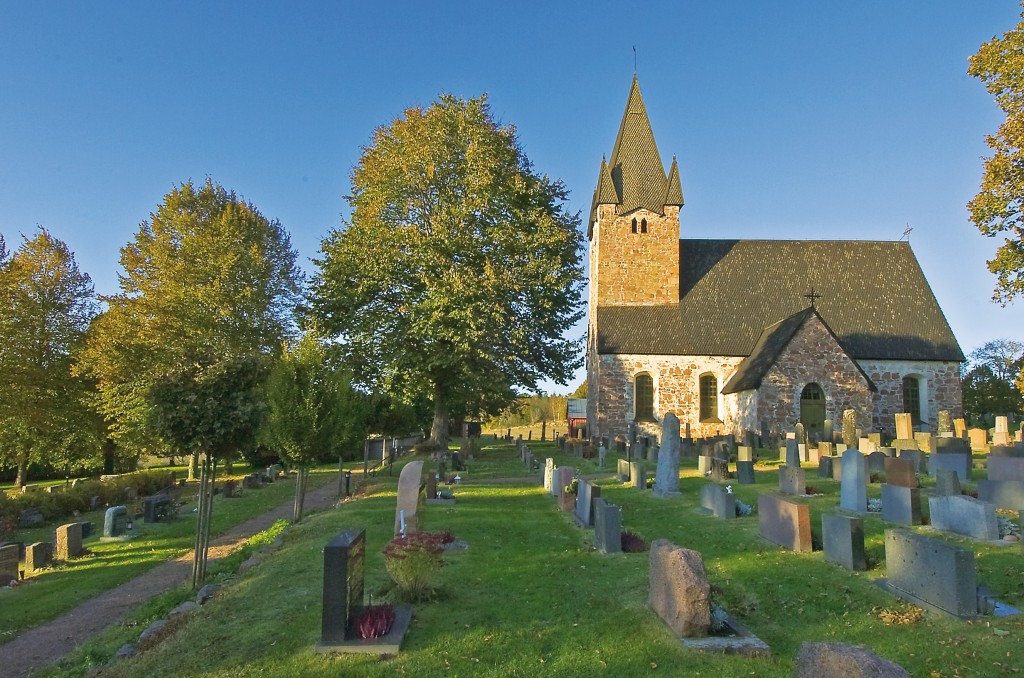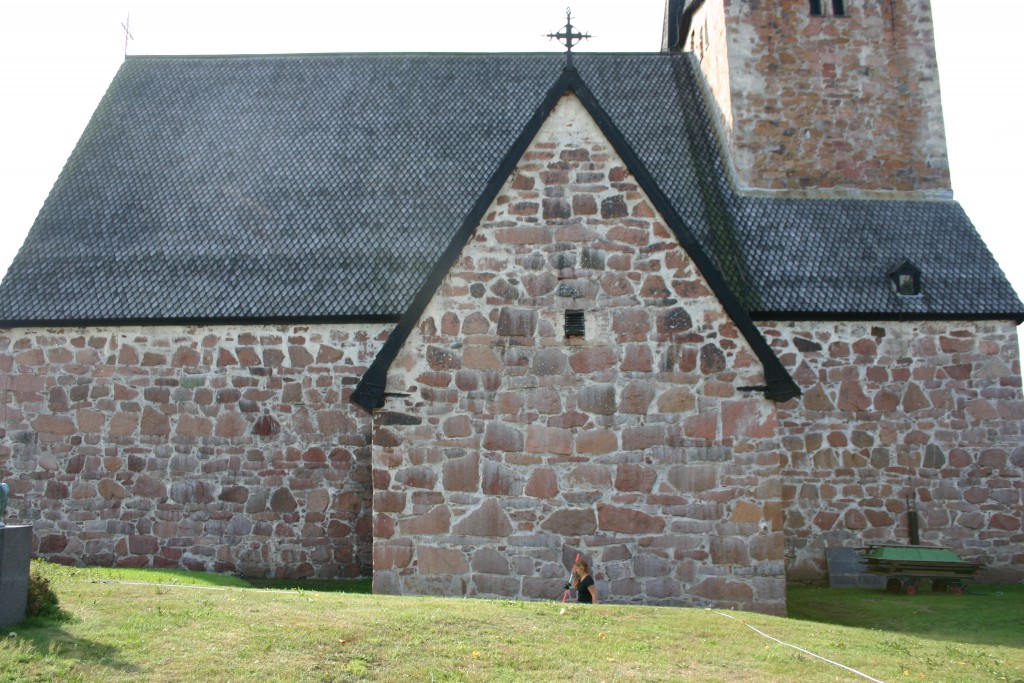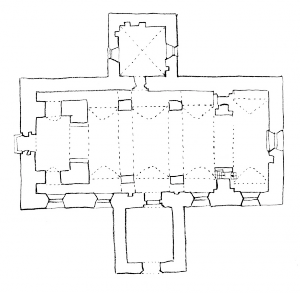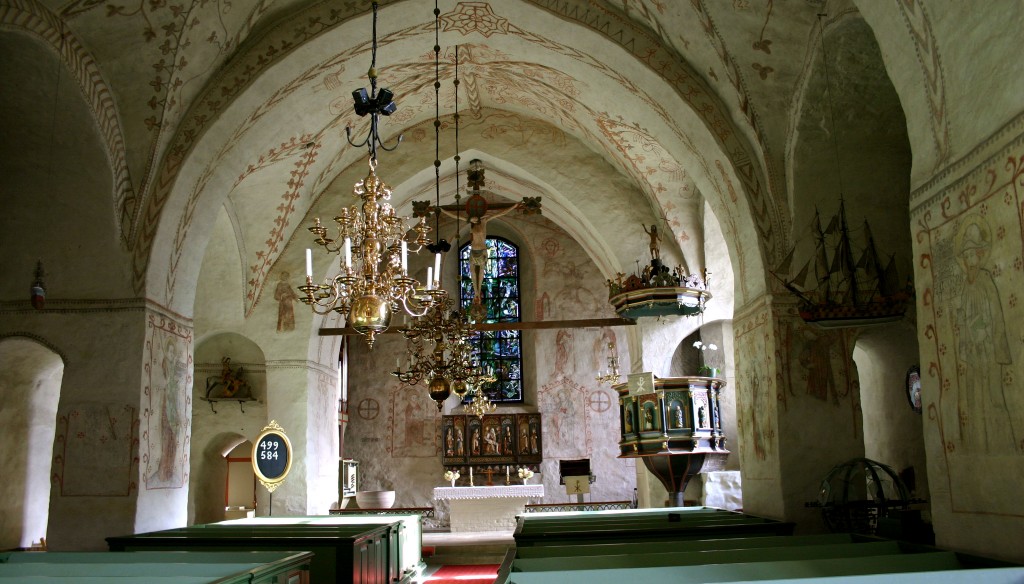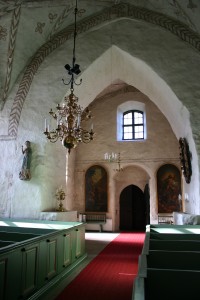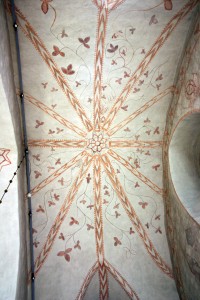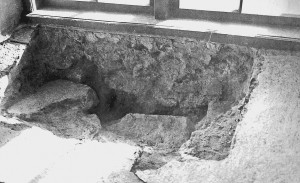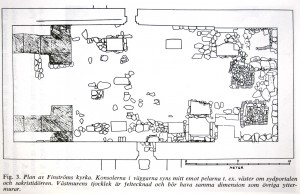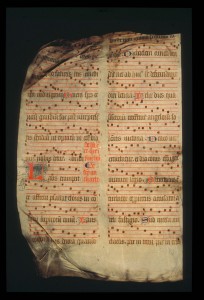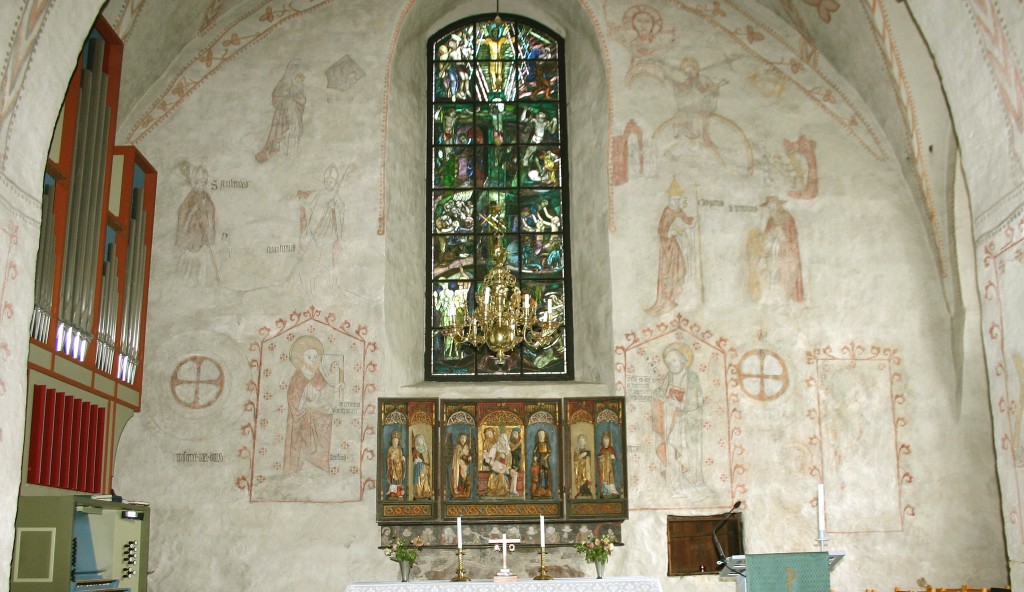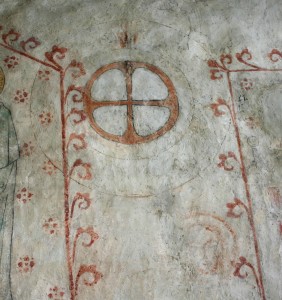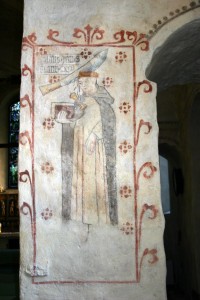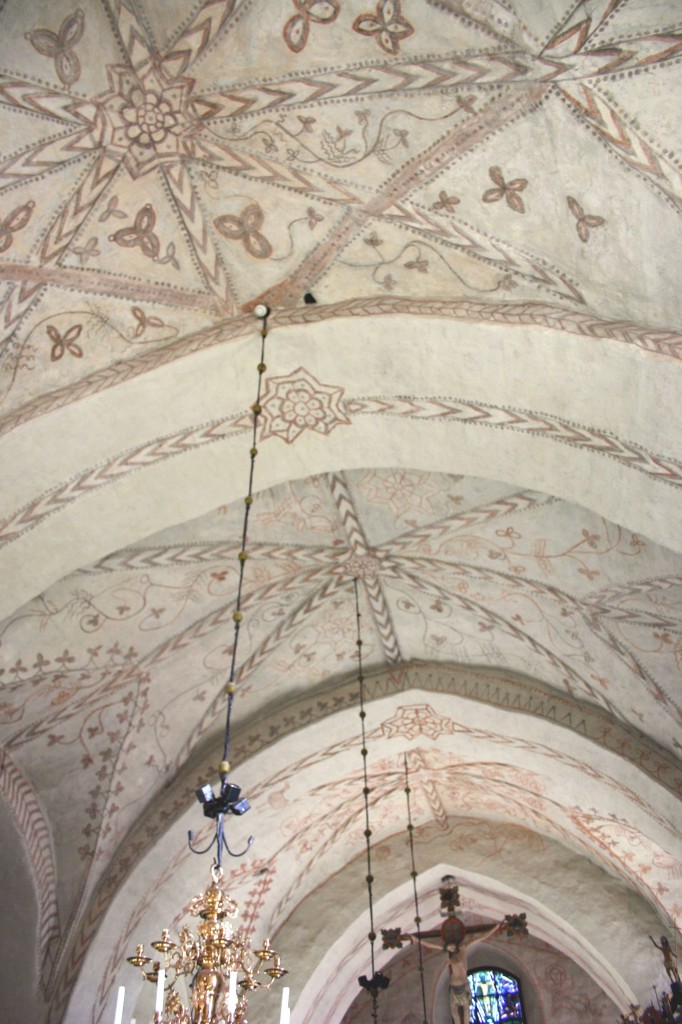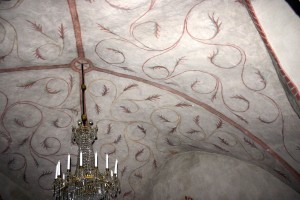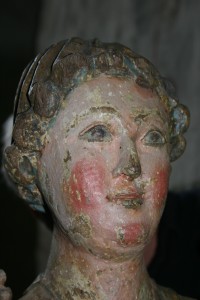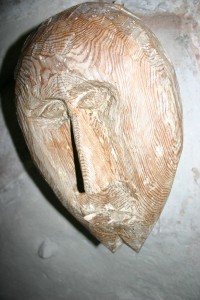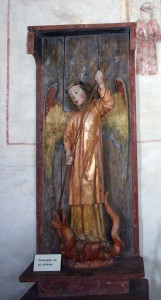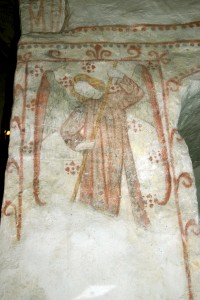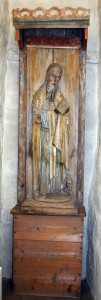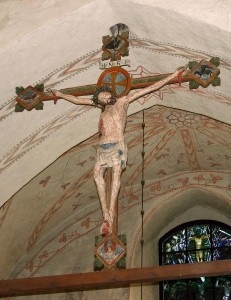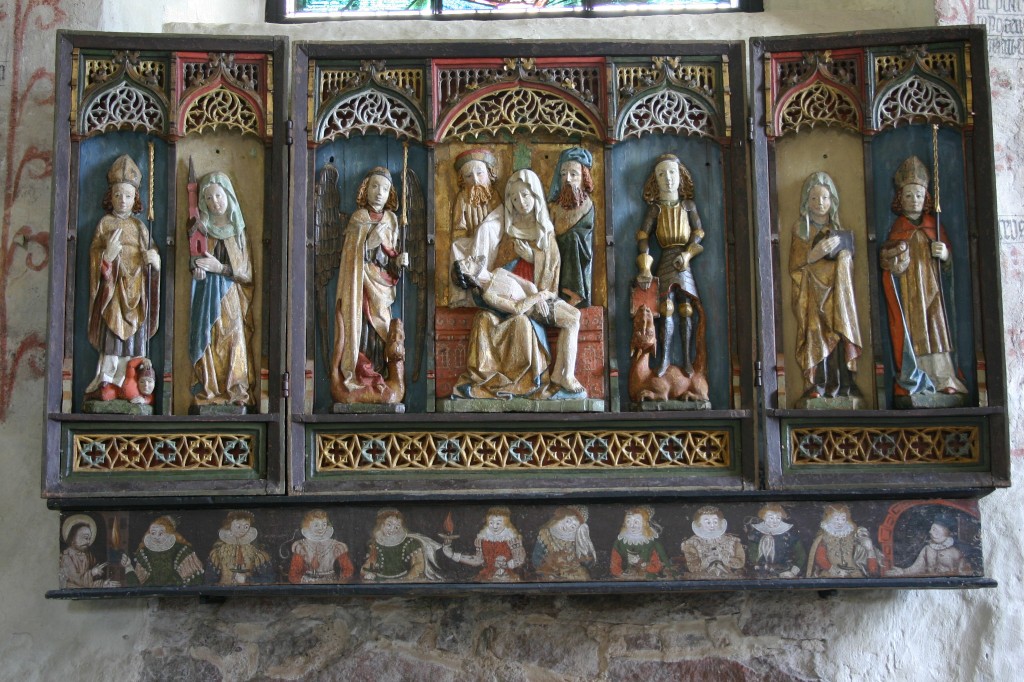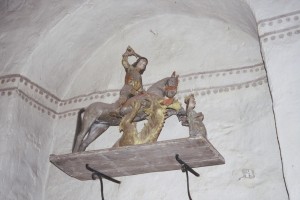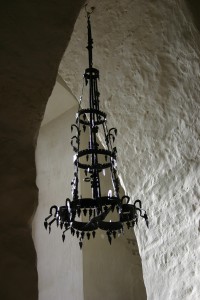Among the Åland mother churches St.Michael’s Church in Finström is the only one not to have been built adjacent to the largest iron-age grave field of the parish. Instead it is mysteriously embedded in deep earth slopes facing north and northeast.
The parish of Finström is centrally located on the main island, surrounded by Jomala, Hammarland, Geta, and Saltvik. The parish is cut by several waterways, with a long coast facing Färjsundet and Ödkarbyviken in the east. Back when the lake Kyrkträsket still could be reached via the Ämnäs straits, the church was situated on an inner bay of the sea, with a well-sheltered harbor.
Finström church. Exterior from the south.
Finström church. Exterior from the north.
The exterior
The church of Finström is the best-preserved medieval building in Finland. This goes for both exterior and interior. The church is not yet fully investigated, and there are still many question marks. The nave has a rectangular ground plan and is built in rapakivi (local Åland red granite), but otherwise it differs from other Åland churches. It lacks the usual simple step-like socle and the separate priest door from the south into the chancel. Nor is the masonry identical. Rather than selected small stones framed by chains of bigger blocks in the corners, there is a distinct pattern with regular shifts. Two layers of bigger stones alternate with smaller horizontally arranged blocks of granite. Four identical large windows face the south, regularly flanking the porch in the center of the façade. A high chancel window dominates the eastern gable. The church of Finström is one of the few in entire Finland to have kept its windowless north wall intact. Here the sacristy, again centrally placed in the façade, interrupts the horizontal shifts. The north gable of the sacristy suggests a secondary heightening. The silhouette is characterized by a steep angle of the roof and a pointed spire, surrounded by four smaller turrets. An unusual solution can be seen in the erection of the tower. Normally, the tower would be erected as a separate building unit in front of the west gable of the nave; here, the tower is drawn into the rectangular plan, where it rests on the western part of the nave vaulting.
Ground plan.
Ground plan
The church has a nearly cruciform ground plan, with the sacristy and porch placed roughly opposite each other on the northern and southern walls of the nave. Rougher wall pillars under the tower show that the tower was included in the planning of the vaults. Joints in the walls clearly show that the porch is secondary to the nave, but when it comes to the sacristy, the building sequence is not so clear. Contradictory signs point to different directions. The rectangular nave is one of the largest in the Islands, with an inner floor of 283 square meters (outer measures 28.9 x 14.4m). The portal of the porch also functions as the main portal of the church. Another portal is located in the longitudinal central axis of the nave.
Interior towards east.
Interior towards west.
The interior
The lack of windows facing north, in combination with well preserved, all-covering wall paintings and the unusual vaulting contribute to the warm and devout atmosphere of the interior. Only minimums of changes were made during the renovation in the 19th century. Existing windows were cautiously enlarged. A rich painting program that had been covered by layers of whitewash on walls and vaults was carefully restored, and the number of preserved wooden sculptures is unusually high. An early medieval side-altar remains intact, as does an early medieval burial slab of limestone, trapezoidal in shape. The vaults in Finström lack parallels. They are roughly cast in fieldstones in four bays, dividing the nave into a wide central nave flanked by narrow aisles or galleries.
The vault of the central nave stretches like a barrel vault along the central axis, flanked by barrel vaults from the aisles, set at right angles. These barrel vaults, originally separated from each other, were united by secondary openings, or narrow side passages, cut through the wall pillars. Thus, rough freestanding square wall pillars were formed to take the weight off the heavy transverse arches. The connection between transverse arches and the wall pillars is awkward. Four niches with rounded arches in the triumphal arch, two facing the altar and two towards the congregation indicate a possible concentration of side altars to this area. The pointed arch under the tower is part of a secondary supporting construction for the tower, which partly hid existing paintings on walls and wall pillars.
Ribs enhanced in low relief show the wish to create an illusion of star vaults with ribs. Under the plaster of the ribs occasional brick stones can be found. The ribs are completely decorative without supporting function. Rather than forming a structural network, they break when meeting the ribs of the aisles, ending in empty spaces in the middle of the vaults. Draining holes sometimes break them up.
Finström. Detail of the chancel vault.
The vaulting is different in the wide triumphal arch between nave and chancel and inside the chancel. It is smoother and more even. The ribs, without reliefs, are an illusion painted directly on the smooth plaster. Trefoil decoration lingers smoothly along the vault.
The history of the church
When the area in front of the west portal was excavated in 1949, a uniform group of early medieval graves was unveiled. The dead had been laid in coffins of stone slabs, with their bones partly under the present west gable.
Lengthways crack in the south wall of the nave, documented during archaeological excavation in 1950.
Excavation reports from the archaeological investigations in 1950 mention a crack lengthways along the south and north walls, approximately 70 cm inside the inner wall surface. Matts Dreijer, county archaeologist, and Hugo Eriksson, building master in charge, interpreted the crack as an indication that the oldest stone walls could have carried a lighter wooden construction, i.e., that the nave was covered by open roof trusses or a wooden vault. They claimed that the walls from the first stone church still remain in the inner walls of the rebuilt church, that they measured ca 70cm in thickness and that they reached a height of 3.20m. The walls would have gained in thickness around 90cm in the secondary vaulting, reaching a thickness of 1.60m. Unfortunately, these observations cannot be verified, but if they are correct, then the original walls would coincide with a painted dotted line which can be followed around the entire interior, except for the chancel.
In archaeological excavations in 1969-70, the stone foundation of a smaller church (around 14 x 8m) was uncovered inside the church. Preserved wooden sculptures of Saint Michael, a human head, and the odd coin, all date this wooden church to the 12th century. The burials mentioned above presumably also belonged to the wooden church.
Excavation plan of Finström church, 1969-70.
This time it is the evidence from archaeological artifacts and historical sources rather than natural sciences that indicates that the first stone church in Finström, unvaulted and with a lower sacristy, was erected approximately simultaneously with other mother churches in the Islands, at the end of the 13th century. Also, a large hoard of coins was hidden in the sacristy some time in the 1280s. It is important to note that the lower part of the sacristy is joined with the northern wall of the nave, and that the hoard therefore belongs to the first stone church. Unfortunately, nobody understood to take mortar samples from the foundation level in the nave and in the sacristy in the archaeological excavations in 1969-70. Today it is considerably harder to reach original mortar, since a thick layer of concrete covered the floor area after the excavations; the stone floor is laid on top of this concrete cover. Inside the church some coins from the 13th century were found, but most of the coins belong to the 14th and 15th centuries. The size and shape of the first stone church remains unclear. Fragments of limestone mullions and stained glass were found in the excavations.
During the 14th century Finström church strengthened its position in the Islands. Energetic vicars with excellent ecclesiastical networks were responsible for that. The first vicar of Finström to be mentioned is Sigurd of Finnaström (ca 1328-42), canon in the Diocese of Turku, confidant of bishops and archbishops. He represents the Islands in the correspondence concerning the seal tithes in 1335-6. An important decision made in this connection was that the seal tithes, used earlier for funding the building of the parish churches in the islands, from now on should be assigned to the vicars in order to support their households. The source concerning the seal tithes is one of the strongest indications that a stone church had already been built in Finström, and that it was seen as relatively finished. Therefore no new building plans were on the agenda. It was probably the very same Sigurd of Finnaström who acquired the new liturgical book of songs, the sequentionarium, from Paris.
“Laus Erumpat ex affectur” sequence of St. Michael, ca 1320.
From now on Finström church stands out as the foremost representative of Dominican influence in Åland. In the 14th century many more vicars from Finström are mentioned. In 1325 King Magnus Eriksson stated that certain parishes within the Diocese of Turku were to be regal, among them Finström. Thus the Swedish crown now had full patronage over the parish of Finström, roughly at the same time as Grelsby Manor, a few kilometers south of the church, was transferred to King Magnus. Through the transaction the previous owner could expiate a crime for homicide. From now on Grelsby Manor is called the King’s Manor. According to information from 1375 the revenue and income from being vicar in Finström did not exceed 18 gold florins annually.
The middle of the 15th century meant a radical building activity in the church. Dendrochronological analysis shows that all building units were involved, and that it took place during an intensive and dynamic building period, which lasted from the 1440s to 1467. This dating of the upper parts of the nave, both in the exterior and the interior, have been confirmed by 14C AMS analysis of mortar. In spite of speculations cited above, we do not know how much remains of the original stone church after this transformation, but apparently the changes were substantial. The façades also changed with the windows matching the new vaulting system.
The great transformation scheme started with a heightening of the sacristy in the 1440s. The vaulting of the nave took place ca 1450, a few years later the porch was erected against the south portal, and as the last step of the extension the west tower was constructed in 1467 on top of the westernmost bay of the central nave. The conspicuous spire at Finström, surrounded by four turrets in each corner reflecting the tower in Turku Cathedral, was later to be a source of inspiration to Sund.
The medieval high altar was larger and “more disproportionate” than it is today. It was standing free from the eastern chancel wall. Finström is one of the few churches where you can still see traces of a medieval ambo*. The staircase of the present pulpit, through the triumphal arch, belongs to the original arrangement.
The crucifix of the church, stylistically dated to ca 1430, still hangs in the triumphal arch. In the south aisle, in front of the triumphal arch, one of the medieval side altars remains intact. The north side altar, consecrated to Mary, has been torn down.
A faithful copy of the equestrian statue of Saint George, from 1498 in the Stockholm Great Church, was executed for the church of Finström. The bottom piece is however older, dendrochronologically dated to the middle of the 15th century. The princess is kneeling in front of the equestrian group, with her back turned against the hero saint. Today the group is placed above the original Mary altar on the northern side of the triumphal wall. Christ is standing on the south side altar, as the Man of Sorrows showing his wounds. In the sacristy we find a wooden sculpture of highest artistic quality, depicting the Swedish national saint Erik.
The wall paintings
The eastern chancel wall, the wall paintings, including a detail of the face of Christ.
Many different stages can be discerned among the wall paintings on the eastern chancel wall. The inauguration crosses in the chancel are among the oldest, with concentric rings inscribed into the wet plaster. Below the south inauguration cross on the eastern chancel wall there is a faintly drawn face of Christ, also with inscribed outlines. After the rebuilding at the middle of the 15th century, the church was covered with wall painting. Even if the time differences are insignificant, it is possible to discern many different masters. The finest paintings, probably also the earliest of the group, comprise the sequence of the church fathers on the chancel wall. Saint Anna is furthest to the north, flanked by the Last Judgment towards the south. The “Maria in Sole”, the enthroned Madonna surrounded by sunrays and sitting on the crescent moon above the original Mary altar in the north, was probably also painted by the same master.
The Credo suite where individual apostles with their text bands represent different parts of the creed has been painted on the walls facing in towards the nave, beginning with Peter south of the high altar and concluding with Matthias north of the high altar. Many apostles from the suite have been covered and damaged by later interference in the church. Individual saints like Michael, George, Henrik, Gertrude, Catherine of Alexandria, and Birgitta of Sweden ornament other surfaces of the walls.
The Dominican saint Peter the Martyr.
The vaulting of the nave, and the ”primitive” paintings.
Apart from the chancel, a line in grey with double dots marks the border between wall surface and vault. A different master has painted the vault in the so-called primitive Western Finnish style. The stars of the sky, Orion’s belt and the Seven Stars, may symbolize the old and the new law according to the Book of Job.
Intertwining foliage ornamentation covering the sacristy vault.
The sculptures
Saint Michael and the “Giant Finn”, early medieval wooden sculptures in Finström church.
A large number of the medieval wooden sculptures still remain intact in situ. Two of them belong to the end of the 12th century – smiling Saint Michael and the so-called Giant Finn secondarily walled into the tower vault. Other sculptures were acquired only after the extensive rebuilding of the church in the 15th century, among them a new Saint Michael, by the sacristy portal, was ordered for the new inauguration of the church. He is framed by a shrine in Åland pine from the same period.
Saint Michael, wooden sculpture from around 1450, and detail of a wall painting of the same sculpture.
Saint Anthony, carved in oak from northern Germany.
Saint Anthony, dendrochronologically dated to the 1450s, is hidden in the far west of the south aisle. The framing shrine, of Åland pine, is contemporary. Note the double framing of the saint. The outer higher shrine, also of Åland pine, dated to around 1230, originally belonged to the Romanesque sculpture of Saint Michael. Consequently, the shrine of Saint Michael, somewhat younger than the sculpture, is not in its proper location.
The crucifix from ca 1430.
The medieval altarpiece in Finström, dendrochronologically dated to around 1460. The corpus presents the Pietà, surrounded by Saint Michael and Saint George, in the wings Nordic saints, from the left, Saint Henrik of Finland, Saint Ingrid of Skänninge (dominican saint), Saint Birgitta and Saint Sigrid of Växjö.
Saint George and the Dragon, wooden sculpture from ca 1490.
The reason for the big rebuilding of the church in the middle of the 15th century is unknown. But it is obvious that Finström during the 15th century further strengthened its close relation to Turku Cathedral. It is confirmed by the coat of arms belonging to Dean Olaus Magni on the eastern chancel wall. The same close relation is shown by the turrets of the tower, obviously inspired by the church tower in Turku. We further have iconographical parallels in Saint Henrik, the patron saint of the Turku Cathedral, found in Finström both as a wall painting and as one of the sculptures in the reredos. The sculpture of Saint Anthony in Finström is a faithful copy of a similar sculpture in Turku Cathedral, etc. At the same time the Dominican influence is strengthened in the images in the church.
A preserved medieval light crown in iron.
The post-reformation
In 1548 Finström church lost a gilded silver monstrance in the confiscations of Gustavus Vasa. After the reformation there were only few architectural changes. The maintenance of the wooden sculptures continued unbroken. Dean Boetius Murenius ordered the sculptures to be repainted and placed according to the wishes of the vicar. To manage the weight of the tower, the underlying vault had to be supported by a stone construction with a pointed arch, probably erected in the early 16th century. The inner walls of the church were whitewashed for the first time in the 1660s. During the 17th century the medieval high altar was replaced by another erected tightly against the east chancel wall.
Baptismal piece, compiled from earlier sculpture in the 17th century.
There is a rarity among the 17th-century decorations in Finström church – a Baptismal piece composed by older wooden sculptures from at least two different altarpieces. Maternity is enhanced. To my knowledge it is very rare to have liturgical objects as a collage of medieval components in the Post-Reformation era. The Pietá in the center is flanked to the right by a female saint usually identified as Saint Gertrude, and by Saint Anne to the left. Dendrochronological analysis of the boards in the background gives a date in the middle of the 17th century. The handwriting in the almost invisible background text reveals that it is by Mårten Johansson.
Pulpit and pews were also installed at the same time. Gradually also galleries were needed for the increasing population. In 1704 it was time to replace the pulpit with a new one. The church’s first organ came as a donation in the 18th century. During the 1830s the south windows were enlarged and the chancel window was prolonged downwards. In the beginning of the 1900s the medieval wall paintings were carefully rescued under layers of secondary whitewash by the architect C.F. Frankenhaeuser. By using new methods he had learnt in Denmark, he succeeded in revealing the wall paintings in Finström almost unharmed in their medieval state. In the 1920s the conservator Oskari Niemi continued in the same spirit to uncover the rest of the medieval wall paintings of the church.
In 1969-1970 a substantial archaeological investigation was performed, before restoration works started. In the process the organ gallery was removed. It received a new location against the north chancel wall.
The modern stained glass window in the chancel, The World Conciliation by the artist Lennart Segerstråle, was uncovered in 1947.
